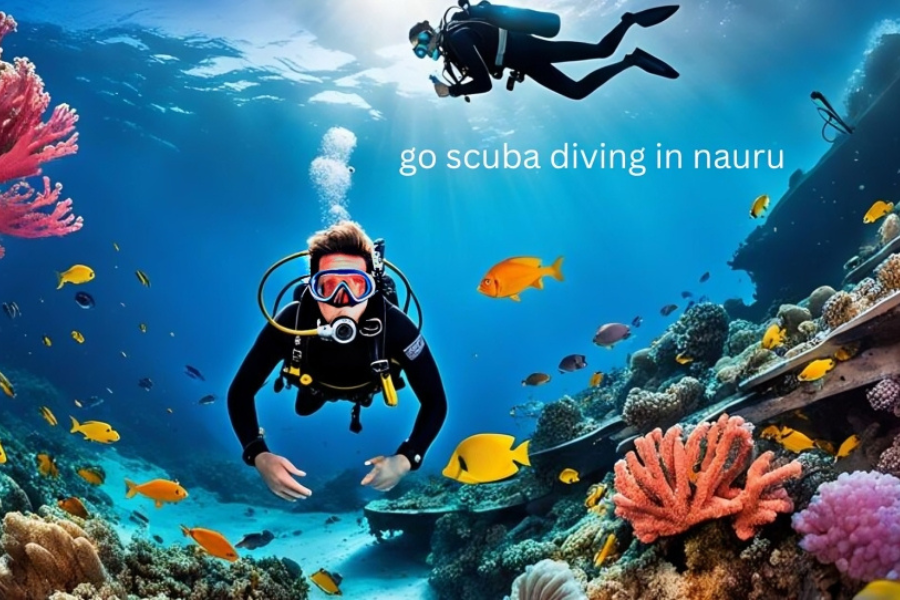Go Scuba Diving in Nauru: A Journey Through Vibrant Marine Life
Introduction
Nestled in the heart of the Pacific Ocean, go scuba diving in nauru is an often overlooked destination that offers a truly exceptional scuba diving experience. Despite its modest size, this hidden gem presents an unparalleled opportunity for underwater enthusiasts. With its pristine waters, vibrant marine life, and unique underwater landscapes, Nauru beckons divers seeking an unforgettable adventure. In this article, we will dive into the wonders of scuba diving in Nauru, exploring its rich marine biodiversity, iconic dive sites, and the overall experience of immersing oneself in this underwater paradise.
Discovering Nauru: An Overview
Nauru, the third smallest country in the world by land area, is located in Micronesia in the central Pacific. This tiny island nation, with a population of around 10,000, is known for its phosphate mining history and unique cultural heritage. Despite its small size, Nauru is surrounded by crystal-clear waters teeming with marine life, making it an ideal spot forgo scuba diving in nauru. The island’s warm, tropical climate and remote location contribute to its status as a hidden gem for divers.
The Marine Biodiversity of Nauru
Nauru’s marine environment is a treasure trove of biodiversity, offering divers go go scuba diving in nauru in nauru a wide variety of species to encounter. The island’s coral reefs are home to an array of colorful corals, reef fish, and other marine creatures. Thanks to its isolation, Nauru’s marine ecosystems have remained remarkably well-preserved, making it a haven for marine life enthusiasts.
Coral Reefs
Nauru’s coral reefs are among the most pristine in the world. Characterized by vibrant colors and diverse structures, these reefs provide a habitat for countless marine species. Hard and soft corals, sea fans, and sponges create a stunning underwater landscape that is both visually captivating and ecologically important. These reefs play a crucial role in supporting the island’s marine biodiversity and offer divers a breathtaking spectacle.
Fish Species
The waters around Nauru are teeming with fish of all shapes and sizes. Divers can encounter schools of colorful reef fish such as parrotfish, butterflyfish, and angelfish. Larger pelagic species like barracuda, trevally, and tuna are also commonly seen. For those interested in spotting bigger marine life, Nauru’s waters are frequented by various shark species, including reef sharks and the occasional hammerhead. The diversity of fish species adds excitement and variety to each dive.
Other Marine Life
Beyond fish, Nauru’s underwater world is inhabited by a plethora of other marine creatures. Sea turtles, including the endangered green and hawksbill turtles, can often be spotted gliding gracefully through the water. Rays, such as manta rays and eagle rays, are also common visitors to Nauru’s reefs. Additionally, divers may encounter octopuses, cuttlefish, and a variety of crustaceans and mollusks, enriching the diving experience with encounters of diverse marine life.
Iconic Dive Sites in Nauru
Nauru offers a range of dive sites that cater to divers of all levels, from beginners to seasoned professionals. Each site has its own unique features, ensuring that every dive is a new and exciting adventure.
Anibare Bay
Anibare Bay is one of Nauru’s most popular dive sites, renowned for its clear waters and abundant marine life. The bay’s shallow reefs are ideal for beginners, offering a chance to explore vibrant coral gardens and encounter schools of tropical fish. More experienced divers can venture deeper to discover intriguing underwater caves and overhangs, adding an element of exploration to their dive.
Buada Lagoon
Buada Lagoon presents a go scuba diving in nauru diving experience with its freshwater environment. Surrounded by lush vegetation, the lagoon provides a tranquil setting for diving. While it may not be as rich in marine life as the coastal reefs, Buada Lagoon is home to several fish species and offers a unique diving experience in a freshwater environment. The serene surroundings make it a peaceful spot for diving.
Pinnacle Rock
Pinnacle Rock is a striking underwater formation that rises from the ocean floor to just below the surface. Known for its dramatic topography, this dive site features steep walls covered in colorful corals and sponges. Divers can explore the various nooks and crannies of the pinnacle, encountering a diverse array of marine life along the way. The visual appeal and the opportunity for exploration make Pinnacle Rock a standout dive site.
Shark Point
As the name suggests, Shark Point is a prime spot for encountering sharks. Located on the outer edge of the reef, this dive site attracts a variety of shark species due to the ocean currents. Divers can often see reef sharks patrolling the area, along with other pelagic species like barracuda and tuna. The thrilling encounters with these apex predators make Shark Point a favorite among adventurous divers seeking a bit of excitement.
The Diving Experience: What to Expect
Scuba diving in Nauru offers a unique blend of adventure, tranquility, and natural beauty. The island’s remote location often means that dive sites are uncrowded, allowing for a more intimate and personal diving experience. The warm waters and excellent visibility make for comfortable and enjoyable dives, while the diverse marine life and stunning underwater landscapes provide endless opportunities for exploration and discovery.
Dive Conditions
Nauru’s tropical climate ensures warm water temperatures year-round, typically ranging from 26°C to 29°C (79°F to 84°F). Visibility is generally excellent, often exceeding 30 meters (100 feet), which allows divers to fully appreciate the beauty of the underwater world. The calm, clear waters make Nauru an ideal destination for divers of all skill levels, from beginners to advanced.
Dive Operators and Facilities
Despite its small size, Nauru has several dive operators that offer guided dives, equipment rental, and certification courses. These operators are staffed by experienced and knowledgeable instructors who are familiar with the local dive sites and marine life. Divers can expect high-quality service and a strong emphasis on safety and conservation. Whether you’re a novice or a seasoned diver, you’ll find professional support to enhance your diving experience.
Conservation and Sustainable Diving
Nauru’s marine environment is a precious resource, and efforts are being made to ensure its protection and preservation. Dive operators in Nauru are committed to sustainable diving practices, including promoting reef-friendly behaviors, minimizing environmental impact, and supporting local conservation initiatives. Divers are encouraged to follow guidelines for responsible diving, such as not touching or disturbing marine life and avoiding contact with the fragile coral reefs. By practicing sustainable diving, visitors help preserve the beauty and health of Nauru’s underwater world.
Cultural and Historical Context
In addition to its natural beauty, Nauru has a rich cultural and historical heritage that adds depth to the diving experience. The island’s history is intertwined with its marine environment, from traditional fishing practices to the impact of phosphate mining on its ecosystem.
Traditional Fishing Practices
The Nauruan people have a deep connection to the ocean, and traditional fishing practices have been passed down through generations. These practices include the use of woven nets, spearfishing, and the construction of fish traps. Understanding these traditional methods provides insight into the island’s cultural heritage and the importance of marine resources to the Nauruan way of life.
Impact of Phosphate Mining
Phosphate mining has had a significant impact on Nauru’s environment and economy. The island’s rich phosphate deposits were extensively mined during the 20th century, leading to environmental degradation and a loss of biodiversity. Today, efforts are being made to rehabilitate the mined areas and promote sustainable development. Divers can observe go scuba diving in nauru efforts and gain a deeper appreciation for the challenges and resilience of the Nauruan people.
Practical Information for Divers
For those planning a diving trip to Nauru, it is important to be well-prepared and informed about the logistics and practicalities of visiting this remote island nation.
Getting There
Nauru is accessible by air, with Nauru International Airport (INU) serving as the main gateway to the island. Flights to Nauru are limited, with connections available from Brisbane, Australia, and other Pacific island nations. It is advisable to check flight schedules and book tickets in advance due to the limited availability of flights.
Accommodation
Accommodation options in Nauru range from budget guesthouses to mid-range hotels. While the island does not have luxury resorts, the available accommodations are comfortable and provide essential amenities. It is recommended to book accommodation in advance, especially during peak travel seasons, to ensure availability.
Health and Safety
Divers should ensure they are in go scuba diving in nauru and fit for diving. It is advisable to have travel insurance that covers diving activities. Nauru has a small hospital and medical facilities, but serious medical emergencies may require evacuation to a larger medical center. Divers should also be aware of the potential risks associated with marine life and follow safety guidelines provided by dive operators.
Conclusion
Nauru may be a small island, but it offers a world of underwater wonders for scuba diving enthusiasts. The island’s pristine coral reefs, diverse marine life, and unique dive sites provide an unforgettable diving experience. Whether you are a seasoned diver or a beginner, Nauru’s clear waters and vibrant marine ecosystems will leave you in awe. As you explore the underwater paradise of Nauru, you will not only discover the beauty of its marine environment but also gain a deeper appreciation for the island’s cultural heritage and the importance of conservation. So pack your diving gear, embark on an adventure, and dive into the hidden go scuba diving in nauru– a truly unique and captivating destination waiting to be explored.
FAQs
1. Why should I consider scuba diving in Nauru?
Nauru offers a unique scuba diving experience due to its pristine coral reefs, diverse marine life, and relatively uncrowded dive sites. The island’s clear waters, vibrant marine ecosystems, and dramatic underwater landscapes make it a must-visit destination for diving enthusiasts seeking a memorable adventure.
2. What is the best time to go scuba diving in Nauru?
The best time to dive in Nauru is during the dry season, which typically runs from May to October. During this period, the weather is more stable, and water visibility is at its best. However, Nauru’s tropical climate allows for enjoyable diving conditions year-round.
3. What marine life can I expect to see while diving in Nauru?
Divers in Nauru can expect to encounter a wide range of marine life, including colorful reef fish (such as parrotfish, butterflyfish, and angelfish), larger pelagic species (like barracuda, trevally, and tuna), and various shark species. Sea turtles, manta rays, eagle rays, octopuses, and cuttlefish are also commonly seen.
4. Are there any specific dive sites in Nauru that are highly recommended?
Yes, several dive sites are particularly popular among divers:
- Anibare Bay: Known for its clear waters and vibrant coral gardens, ideal for both beginners and experienced divers.
- Buada Lagoon: Offers a unique freshwater diving experience surrounded by lush vegetation.
- Pinnacle Rock: Features dramatic underwater topography with colorful corals and diverse marine life.
- Shark Point: Famous for shark sightings and pelagic species, making it a thrilling spot for adventurous divers.
5. Do I need to have prior diving experience to dive in Nauru?
While some dive sites in Nauru cater to beginners, such as Anibare Bay, it is advisable to have some basic diving experience or certification. For more advanced dives, such as those at Pinnacle Rock or Shark Point, a higher level of diving certification and experience may be required.
6. What are the water conditions like for diving in Nauru?
Nauru’s water temperatures range from 26°C to 29°C (79°F to 84°F) year-round, providing comfortable diving conditions. Visibility is generally excellent, often exceeding 30 meters (100 feet), which enhances the diving experience. The calm waters make Nauru an ideal destination for divers of all skill levels.
7. Are there dive operators in Nauru?
Yes, Nauru has several dive operators that offer guided dives, equipment rental, and certification courses. These operators are experienced and knowledgeable about the local dive sites and marine life, ensuring a safe and enjoyable diving experience.
8. How can I get to Nauru?
Nauru is accessible by air via Nauru International Airport (INU). Flights are limited and typically connect from Brisbane, Australia, and other Pacific island nations. It is recommended to check flight schedules and book in advance due to limited flight options.
9. What accommodation options are available in Nauru?
Accommodation in Nauru ranges from budget guesthouses to mid-range hotels. While there are no luxury resorts, the available options provide essential amenities and comfort. Booking accommodation in advance is advisable, especially during peak travel seasons.
10. What should I know about health and safety when diving in Nauru?
Divers should ensure they are fit for diving and have appropriate travel insurance that covers diving activities. Nauru has basic medical facilities, but serious emergencies may require evacuation. Be aware of potential risks associated with marine life and follow safety guidelines provided by dive operators.
11. How does scuba diving in Nauru contribute to conservation efforts?
Dive operators in Nauru promote sustainable diving practices, including reef-friendly behaviors and minimizing environmental impact. By following responsible diving guidelines, such as avoiding contact with coral reefs and not disturbing marine life, divers help support local conservation initiatives and preserve Nauru’s underwater environment.
12. What cultural and historical aspects should I be aware of while visiting Nauru?
Nauru has a rich cultural heritage, including traditional fishing practices that have been passed down through generations. The island’s history of phosphate mining has also impacted its environment and economy. Understanding these aspects provides a deeper appreciation of Nauru’s cultural and historical context during your diving experience.
Get the inside scoop on celebrity fashion and red carpet looks at SyncTimes.co.uk






